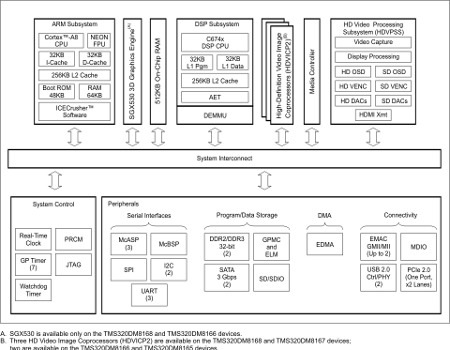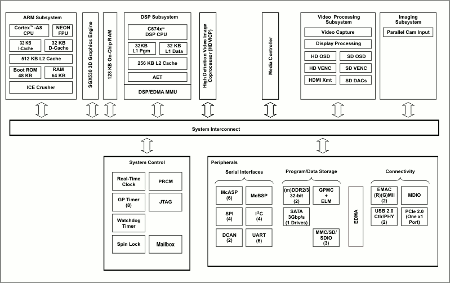Cortex-A8 SoC taps DSP for triple 1080p60 streams
Mar 1, 2011 — by Eric Brown — from the LinuxDevices Archive — 28 viewsTexas Instruments announced several Linux-ready system-on-chips (SoCs) with multiuser HD conferencing and analytics capabilities. With ARM Cortex-A8 cores and TI DSPs, the high-end TMS320DM8168 can power up to three simultaneous 1080p60 frames per second (fps) video streams, or 12 simultaneous 720p30 streams, while the more power-efficient TMS320DM8148 supports a single 1080p60 fps video stream or three simultaneous 720p30 video streams, says TI.
The new DM81x DaVinci processors support HD video communications, real-time automotive vision systems, and high quality entertainment applications, says Texas Instruments (TI). More specifically, the DM8168 is said to be aimed at multi-channel HD video surveillance systems, video-conferencing systems, media hubs and servers, and video broadcasting systems.
The DM8148, meanwhile, targets power-sensitive, consumer and medical video applications requiring fewer video streams, says TI. These are said to include Skype video cameras, interactive digital signage, video surveillance DVRs or IP net-cams, streaming media players, and network projectors.
TI actually first announced the DM8168 in May of last year, but offered relatively little detail. And our examination of the company's datasheets now shows that, apart from the DM8148, there are four other related products that weren't formally announced:
- the 720MHz DM8164 and the 3D-enabled 720MHz DM8165
- the DM8167, which offers a 1GHz CPU like the DM8168, but lacks the latter's SGX530 3D graphics engine
- and the non-3D-enabled, 1GHz DM8147
All six of the processors are equipped with a TI C64x+ DSP (digital signal processor). The DSPs are clocked at 667MHz (DM8165 and DM8166), 750MHz (DM8147 and DM8148), or 1GHz (DM8147 and DM8148), respectively.

TI DM816x DaVinci block diagram
(Click to enlarge)
The DM8168 also offers up to three high-definition video/imaging coprocessors (HDVICP2). The other models offer one or two HDVICP2 chips.
The lower-power DM8148 processor enables a single 1080p60 stream, or three simultaneous 720p30 streams, says TI. Alternatively, it can run multiple lower resolution streams at 3 Watts, says the company.
Aside from the differing ARM and DSP clock rates, and the presence - or lack of — of the Imagination Technologies SGX530 3D graphics accelerator, the six SoCs are fairly similar. There are, however, some differences in the number of interfaces, as shown in the spec list below.

TI DM814x DaVinci block diagram
(Click to enlarge)
In addition, to the interfaces shown in the list below, the block diagrams both show McBSP interfaces for all the processors, while the DM8048 is also said to offer dual "DCAN" interfaces.
Features and specifications listed for the DM816x and DM814x DaVinci SoCs include:
- CPU — 1 x ARM Cortex-A8 @ 1GHz (DM8167, DM8168, DM8147, DM8148) or 720MHz (DM8165, DM8166)
- DSP — TI C674x @ 667MHz (DM8165, DM8166), 750MHz (DM8147, DM8148), or 1GHz (DM8147, DM8148)
- 3D graphics engine — Imagination Technologies SGX530 (DM8148, DM8166, DM8168 only)
- Cache — L1/SRAM 64KB (ARM), 64KB (DSP); L2/SRAM 256KB (ARM), 256KB (DSP)
- Memory:
- 2 x 32-bit DDR2/DDR3
- DDR2 @ up to 400MHz (DM814x) or 800MHz (DM816x)
- DDR3 @ up to 800MHz (DM814x) or 1.6GHz (DM816x)
- 1 x 16-bit GPMC
- Ext. memory — DDR2, DDR3, NOR flash, NAND flash, SRAM, pseudo-SRAM, SD
- 64-Ch EDMA
- Expansion — 1 x PCIe interface
- Display interfaces:
- 2 x output
- 2 x input
- 4 x SD DACs
- 1 x HDMI TX
- HDVICP2 co-processor — 1 x (DM814x) ; 2 x (DM8165/6); 3 x (DM8167/8)
- 2 x LCD
- Networking — 1 x gigabit Ethernet
- Other I/O:
- 2 x USB 2.0
- 2 x I2C
- 1 x SPI
- McASP — 6 x (DM814x); 3 x (DM816x)
- SATA — 1 x (DM814x); 2 x (DM816x)
- UART — 6 x (DM814x); 3 x (DM816x)
- Timers — 7 x 32-bit GP; 1 x32-bit WD
- Core power supply — 1.1 V, 1.2 V (DM814x); 1.0 V (DM816x)
- I/O power supply — 1.5 V, 1.8 V, 3.3 V
- Operating system - Linux, Android, Windows Embedded Compact 7
The DM8168 and software-compatible DM8148 and their variants are offered with TI's Linux-based EZ software development kit (SDK). For applications not needing video processing, the same EZ SDK can be used to migrate to the pin-for-pin compatible TI Sitara ARM processors or TI's 1,5GHz C6-Integra DSP + ARM platforms, says the company.
Android support for the new DaVinci SoCs will follow in the second quarter, with Windows Embedded Compact 7 support slated for the third quarter, says TI.
DaVinci background
TI's DaVinci family of video-oriented SoCs includes multiple devices, some sporting both ARM9 application processors and DSPs, some with only ARM9 processors, and some that are only DSPs. Examples with ARM9 CPUs and DSPs on board include TI's first DaVinci chips, the TMS320DM6443 and TMS320DM6446, announced back in 2005, as well as the later TMS320DM6467. DaVinci processors equipped with only ARM9 CPUs include the TMS320DM335, TMS320DM355, and TMS320DM365.
A TMS320DM6467T DaVinici SoC released in Nov. 2009 runs its DSP at 1GHz, but its ARM9 core clocks at 500MHz. In August of last year, TI announced a DM3730 DaVinci processor that is being used by the latest BeagleBoard-xM. The SoC offers a 1GHz Cortex-A8 core, a 800MHz C64x+ DSP core, and a 3D graphics accelerator. At the same time, TI announced the DaVinci DM3725 model, which is similar except for its lack of 3D support.
Stated Niels Anderskouv, vice president, Digital Signal Processing Systems, TI, "TI is an integral part of the technology innovations that will further bring people together — with real-time video conferencing today and 3D video and gesturing technologies tomorrow."
Stated Jim McGregor, chief technology strategist at In-Stat, "The advancements TI is making in video will enable many of the applications we will come to expect on all devices in the future, such as 3D, augmented reality and mind-blowing gaming."
Availability
The DM8168 DaVinci digital media processors are sampling today, with production pricing starting at $75 per 1ku. The efficient DM8148 DaVinci processors will begin sampling in 3Q 2011, with production pricing starting at $51 per 1ku. A TMDXEVM8168 development platform will cost $1,995.
TI's Linux development package, EZ SDK, is available for download now, while Android support will be available in 2Q 2011, followed by Microsoft Windows Embedded Compact 7 support in 3Q 2011, says TI.
More information may be found on TI's DM816x and DM814x pages, respectively.
TI is demonstrating its new DaVinci processors at Embedded World in Nuremburg, Germany, Mar. 1-3, at Hall 12, Stand #436.
This article was originally published on LinuxDevices.com and has been donated to the open source community by QuinStreet Inc. Please visit LinuxToday.com for up-to-date news and articles about Linux and open source.